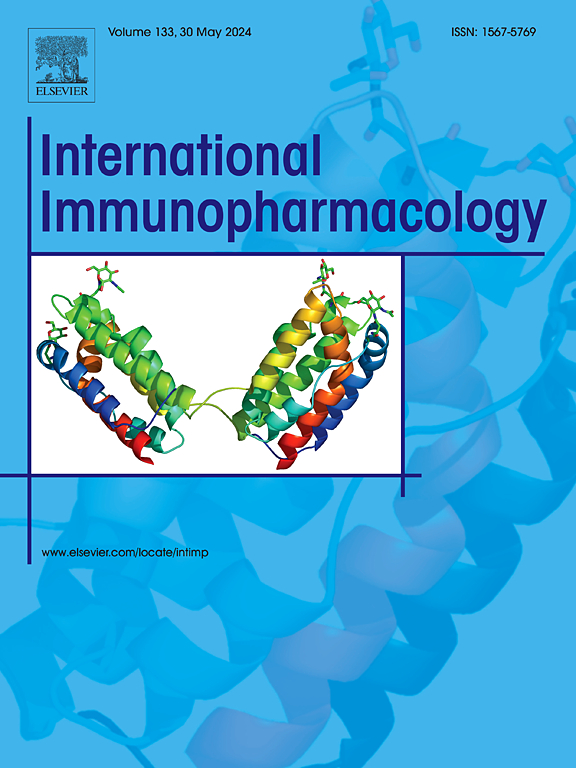Nicotinamide mononucleotide ameliorates hypertriglyceridemia pancreatitis via NAD+/SIRT1-mediated TXNIP suppression and NOTCH pathway for accelerated repair-associated processes
IF 4.8
2区 医学
Q2 IMMUNOLOGY
引用次数: 0
Abstract
Background & Aims: Acute pancreatitis (AP) is a life-threatening condition, and hypertriglyceridemia (HTG) is recognized as a factor exacerbating AP and impeding pancreatic regeneration. Nicotinamide mononucleotide (NMN), a precursor in the biosynthesis of nicotinamide adenine dinucleotide (NAD+), is extensively utilized to restore NAD+ levels. However, the impact of NMN on HTG-AP has not been previously addressed, which prompted our investigation into its effects and underlying mechanisms in this study.
Methods & Results: Here, through bioinformatics analysis and in vivo experiments, we identified abnormalities in the thioredoxin system. In vitro studies revealed that NMN rescued oleic acid (OA)- and palmitic acid (PA)-induced mitochondrial dysfunction and cellular injury in pancreatic acinar cells by suppressing thioredoxin-interacting protein (TXNIP) through NAD+/sirtuin 1 (SIRT1) signaling. Repeated administration of NMN significantly ameliorated P407 and caerulein (CER)-induced pancreatic injury and dysfunction in mice. Consistently, NMN exhibited the potential to reduce inflammatory responses, lower serum lipid levels, and mitigate the accumulation of reactive oxygen species (ROS). More importantly, sustained NMN treatment inhibited the NOTCH pathway and promoted M2-type macrophage dominance during the pancreatic repair phase, influencing early or late macrophage polarization, which significantly enhanced inflammation resolution. As expected, in vitro models using mouse bone marrow-derived macrophage (BMDM), RAW 264.7, and THP-1 cells confirmed that NMN influences macrophage phenotype through the NOTCH pathway.
Conclusions: Therefore, NMN ameliorates pancreatic acinar cell injury via NAD+/SIRT1-mediated TXNIP suppression and may influence macrophage polarization by inhibiting NOTCH activation, offering a novel therapeutic strategy for the treatment and repair of HTG-AP.
背景& 目的:急性胰腺炎(AP)是一种危及生命的疾病,而高甘油三酯血症(HTG)被认为是加重急性胰腺炎和阻碍胰腺再生的一个因素。烟酰胺单核苷酸(NMN)是烟酰胺腺嘌呤二核苷酸(NAD+)生物合成的前体,被广泛用于恢复 NAD+ 水平。然而,NMN对HTG-AP的影响此前尚未得到研究,这促使我们在本研究中对其影响和潜在机制进行调查:通过生物信息学分析和体内实验,我们发现了硫代氧化酶系统的异常。体外研究发现,NMN 可通过 NAD+/sirtuin 1 (SIRT1) 信号抑制硫代氧化还蛋白相互作用蛋白 (TXNIP),从而缓解油酸 (OA) 和棕榈酸 (PA) 诱导的胰腺尖腺细胞线粒体功能障碍和细胞损伤。重复施用 NMN 能明显改善 P407 和茶碱(CER)诱导的小鼠胰腺损伤和功能障碍。一致的是,NMN 具有减轻炎症反应、降低血清脂质水平和缓解活性氧(ROS)积累的潜力。更重要的是,持续的 NMN 治疗可抑制 NOTCH 通路,促进 M2 型巨噬细胞在胰腺修复阶段的优势,影响巨噬细胞的早期或晚期极化,从而显著增强炎症的缓解。正如预期的那样,使用小鼠骨髓衍生巨噬细胞(BMDM)、RAW 264.7和THP-1细胞的体外模型证实,NMN通过NOTCH通路影响巨噬细胞表型:因此,NMN 可通过 NAD+/SIRT1 介导的 TXNIP 抑制改善胰腺尖锐湿疣细胞损伤,并可通过抑制 NOTCH 激活影响巨噬细胞极化,从而为 HTG-AP 的治疗和修复提供一种新的治疗策略。
本文章由计算机程序翻译,如有差异,请以英文原文为准。
求助全文
约1分钟内获得全文
求助全文
来源期刊
CiteScore
8.40
自引率
3.60%
发文量
935
审稿时长
53 days
期刊介绍:
International Immunopharmacology is the primary vehicle for the publication of original research papers pertinent to the overlapping areas of immunology, pharmacology, cytokine biology, immunotherapy, immunopathology and immunotoxicology. Review articles that encompass these subjects are also welcome.
The subject material appropriate for submission includes:
• Clinical studies employing immunotherapy of any type including the use of: bacterial and chemical agents; thymic hormones, interferon, lymphokines, etc., in transplantation and diseases such as cancer, immunodeficiency, chronic infection and allergic, inflammatory or autoimmune disorders.
• Studies on the mechanisms of action of these agents for specific parameters of immune competence as well as the overall clinical state.
• Pre-clinical animal studies and in vitro studies on mechanisms of action with immunopotentiators, immunomodulators, immunoadjuvants and other pharmacological agents active on cells participating in immune or allergic responses.
• Pharmacological compounds, microbial products and toxicological agents that affect the lymphoid system, and their mechanisms of action.
• Agents that activate genes or modify transcription and translation within the immune response.
• Substances activated, generated, or released through immunologic or related pathways that are pharmacologically active.
• Production, function and regulation of cytokines and their receptors.
• Classical pharmacological studies on the effects of chemokines and bioactive factors released during immunological reactions.

 求助内容:
求助内容: 应助结果提醒方式:
应助结果提醒方式:


